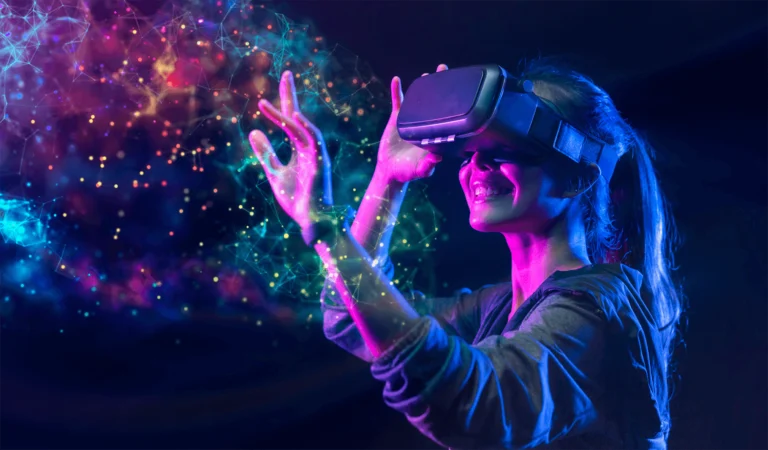Introduction
In 2025, Virtual Reality (VR) and Augmented Reality (AR) are more immersive, interactive, and widespread than ever. These technologies are transforming gaming, education, healthcare, retail, and remote collaboration, enhancing how users engage with digital and physical environments. This blog explores how VR and AR are evolving, their applications, benefits, challenges, and future trends.
What Are VR and AR?
- Virtual Reality (VR): A fully immersive experience where users interact with a simulated environment via VR headsets.
- Augmented Reality (AR): Enhances the real world by overlaying digital elements onto physical surroundings using AR glasses, smartphones, or headsets.
- Mixed Reality (MR): A blend of VR and AR where users interact with both virtual and real-world objects seamlessly.
Key Applications of VR & AR in 2025
1. Gaming & Entertainment
- Fully immersive VR games with real-time physics and AI-powered NPCs.
- AR-enhanced mobile games that blend digital elements into real-world environments.
- AI-driven VR storytelling and interactive metaverse experiences.
Example: Meta’s Quest 3 and Apple Vision Pro push immersive gaming boundaries, offering haptic feedback and real-world object tracking.
2. Healthcare & Medical Training
- VR-powered surgeries allow doctors to practice complex procedures safely.
- AR aids in real-time diagnostics and remote consultations.
- Mental health therapy uses VR exposure therapy for PTSD and anxiety treatments.
Example: Hospitals integrate AR for 3D visualization of patient anatomy to enhance diagnosis and treatment.
3. Education & Workforce Training
- VR classrooms offer virtual field trips and hands-on simulations.
- AR enhances STEM education by bringing historical figures, scientific concepts, and real-world simulations into lessons.
- Enterprise VR training programs for onboarding, safety procedures, and skill-building.
Example: Schools and universities leverage AI-powered VR learning experiences, making education more engaging and effective.
4. Retail & E-Commerce
- AR-powered virtual try-ons for clothing, accessories, and makeup.
- VR showrooms allow customers to explore products in a 3D virtual space.
- AI-driven personalized shopping experiences using AR recommendations.
Example: Brands like IKEA and Nike use AR for virtual furniture placement and interactive product testing.
5. Remote Work & Collaboration
- VR-based virtual offices and meetings enhance remote teamwork.
- AR-powered holographic presentations and real-time collaboration tools.
- AI-driven VR workspaces improve productivity and engagement.
Example: Companies like Microsoft and Meta develop VR-powered virtual offices for hybrid work solutions.
6. Real Estate & Architecture
- VR house tours let buyers explore properties remotely.
- AR enables real-time 3D architectural visualization for construction planning.
- AI-driven VR simulations allow urban planners to design smart cities.
Example: Architects use VR modeling tools for client presentations and building previews.
7. Automotive & Manufacturing
- VR-based design and prototyping accelerate product development.
- AR-powered assembly line training and real-time maintenance assistance.
- AI-driven VR crash testing and vehicle simulations.
Example: Automakers like Tesla and BMW use VR for vehicle design and testing before production.
Benefits of VR & AR
1. Enhanced User Engagement
Immersive experiences increase learning retention, productivity, and user satisfaction.
2. Real-Time Data Integration
AR enables instant access to real-time data, improving decision-making in healthcare, business, and logistics.
3. Cost-Effective Training & Development
VR reduces training costs by offering realistic simulations without the need for physical materials.
4. Improved Accessibility & Inclusivity
AR/VR enhances accessibility for individuals with disabilities, enabling inclusive experiences in education, work, and entertainment.
Challenges of VR & AR in 2025
1. High Hardware Costs & Adoption Barriers
- VR headsets and AR glasses remain expensive for mainstream adoption.
- Businesses require significant investment in infrastructure and software.
2. Privacy & Security Risks
- Real-time data collection in AR/VR environments raises concerns about data privacy and security.
- AI-driven personalization may increase risks of user profiling and surveillance.
3. Motion Sickness & Health Concerns
- VR experiences may cause motion sickness and eye strain.
- Long-term exposure may impact vision and cognitive function.
4. Content & Software Limitations
- Limited high-quality AR/VR content affects user adoption.
- Developers need more intuitive creation tools to expand VR/AR ecosystems.
Future Trends in VR & AR (2025 & Beyond)
1. AI-Powered VR & AR Experiences
- AI-driven realistic avatars, NPCs, and virtual assistants.
- AI-powered voice recognition for seamless interaction.
2. VR & AR in the Metaverse
- Virtual spaces will replace traditional social media, fostering fully immersive online communities.
- 3D digital twins of real-world locations for virtual tourism and events.
3. Wearable AR Devices & Smart Glasses
- AR smart glasses with AI-powered real-time translation and data overlays.
- Lightweight, wireless VR headsets with 8K resolution and eye tracking.
4. 6G & Edge Computing Enhancements
- Ultra-fast connectivity will reduce VR/AR latency for seamless streaming.
- Edge computing will enable cloud-based AR experiences without bulky hardware.
5. Haptic Feedback & Full-Body VR
- Advanced haptic suits and gloves for realistic VR interactions.
- Brain-computer interfaces (BCIs) to enable thought-controlled VR experiences.
Conclusion
VR and AR in 2025 are transforming industries, creating new digital realities and immersive experiences. While challenges remain, continued advancements in AI, connectivity, and hardware will drive broader adoption.
What’s Next?
Are you ready to explore the future of VR and AR? Stay informed about cutting-edge innovations, emerging trends, and industry disruptions.








